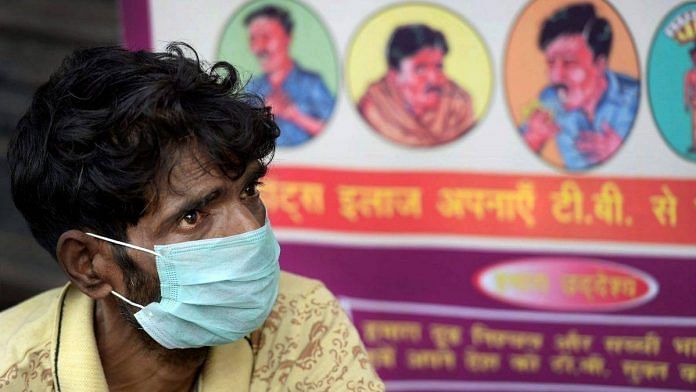New Delhi: At 27 percent, India carries the highest burden of tuberculosis, the World Health Organization (WHO) has said in its latest report on the highly contagious bacterial disease.
The WHO Global Tuberculosis Report 2023, released Tuesday, said that 30 high TB-burden countries accounted for 87 percent of the world’s total cases in 2022. Moreover, it said that two-thirds of the total came from eight countries: India (27 percent), Indonesia (10 percent), China (7.1 percent), the Philippines (7.0 percent), Pakistan (5.7 percent), Nigeria (4.5 percent), Bangladesh (3.6 percent) and the Democratic Republic of the Congo (3.0 percent).
This comes months after a report from India’s Ministry of Health and Family Welfare said that the year 2022 had seen a record-high notification of 24.2 lakh tuberculosis cases. This, according to the ‘India TB Report 2023’, translated into a notification rate of 172 per lakh population from 153 per lakh population in 2021.
This could come as a setback for India, which is aiming for an 80 percent reduction in TB incidence and 90 percent reduction in TB mortality by 2025 — five years ahead of the global target of 2030.
According to the WHO report released Tuesday, the incidence of TB was 28.2 lakh in 2022. Of these, about 22.5 lakh were new and relapsed cases.
In its accompanying news release, WHO said that despite significant recovery in 2022 in the scale-up of TB diagnosis, progress was insufficient to meet global targets set in 2018, with disruptions caused by the pandemic and ongoing conflicts being major contributing factors.
It said that the “net decrease in TB-related deaths from 2015 to 2022 was 19 percent, falling far short of the WHO End TB Strategy milestone of a 75 percent reduction by 2025”.
“…the cumulative reduction in the TB incidence rate from 2015 to 2022 was 8.7 percent, far from the WHO End TB Strategy milestone of a 50 percent reduction by 2025,” the WHO said, adding that about 50 percent of TB patients and their households face “total costs that are catastrophic, far from the WHO End TB Strategy target of zero”.
These costs include “direct medical expenditures, non-medical expenditures, and indirect costs such as income losses that amount to more than 20 percent of total household income”, according to the release.
Also Read: India challenges WHO global modelling estimates for TB, is first to develop own model
‘Even more efforts are needed’
TB is caused by a bacteria called Bacillus Mycobacterium Tuberculosis, which is spread when people who are sick with TB expel the bacteria into the air (mostly by coughing).
According to the report, in all, 7.5 million TB cases were diagnosed globally — the highest since the WHO started monitoring the disease in 1995.
The report said two countries — India and Indonesia — together accounted for 56 percent of the increase in TB cases between 2021 and 2022.
“Previously, they were also the main contributors to the large global increase in TB case notifications that occurred between 2013 and 2019,” it said. “The two other countries that made major contributions to the global increase between 2021 and 2022 were the Philippines and Pakistan (11% and 8.4% of the global increase, respectively).”
India, Indonesia, and the Philippines together accounted for over 60 percent of the global reductions in new TB cases in 2020 and 2021, the report said, adding that the reduction in cases had now gone back to the pre-pandemic level.
For India, the report estimated that the incidence of the disease is 199 per lakh population while 3,38,400 people succumbed to it last year. It also said that of the total incidence, 22.5 lakh cases began their TB treatment last year.
“About a quarter of the global population is estimated to have been infected with TB. Following infection, the risk of developing TB disease is highest in the first 2 years (approximately 5 percent), after which it is much lower. While most people clear the infection, some go on to develop the disease,” the report said.
According to the news release by the WHO, the report “underscores a significant worldwide recovery in the scale-up of TB diagnosis and treatment services in 2022. It shows an encouraging trend starting to reverse the detrimental effects of COVID-19 disruptions on TB services.”
It also underlines that while global efforts have saved over 75 million lives since the year 2000, “even more efforts are needed as TB remains the world’s second leading infectious killer in 2022”.
Drug-resistant TB: a continuing public health crisis
According to the report, multidrug-resistant TB (MDR-TB) remains a public health crisis — while an estimated 4,10,000 people developed multidrug-resistant or rifampicin-resistant TB (MDR/RR-TB) in 2022, only about two in five people accessed treatment.
It also said that in India, 2.5 percent of the new cases and 13 percent of the previously treated cases had emerged as MDR-TB.
Significantly, the ‘India TB Report 2023’ said that the year 2022 saw an increase of 32 percent in the number of drug-resistant cases detected under the National TB Elimination Programme as compared to 2021.
(Edited by Uttara Ramaswamy)
Also Read: This World TB Day, a look at how an Indian PPP initiative made it to WHO list of best practices






